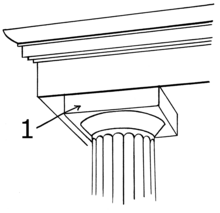
Bowtell is derived from the medieval term bottle;[1] in architecture it refers to a round or corniced molding below the abacus in a Tuscan or Roman Doric capital; the word is a variant of boltel, which is probably the diminutive of bolt, the shaft of an arrow or javelin. A roving bowtell is one which passes up the side of a bench end and round a finial, the term roving being applied to that which follows the line of a curve.[2]
Notes
[edit]- ^ Treatise on architecture:..., ed. Arthur Ashpitel, p. 94, (Edinburgh 1867). A round molding can also be referred to as a torus.
- ^ One or more of the preceding sentences incorporates text from a publication now in the public domain: Chisholm, Hugh, ed. (1911). "Bowtell". Encyclopædia Britannica. Vol. 4 (11th ed.). Cambridge University Press. p. 349.
Well, that’s interesting to know that Psilotum nudum are known as whisk ferns. Psilotum nudum is the commoner species of the two. While the P. flaccidum is a rare species and is found in the tropical islands. Both the species are usually epiphytic in habit and grow upon tree ferns. These species may also be terrestrial and grow in humus or in the crevices of the rocks.
View the detailed Guide of Psilotum nudum: Detailed Study Of Psilotum Nudum (Whisk Fern), Classification, Anatomy, Reproduction